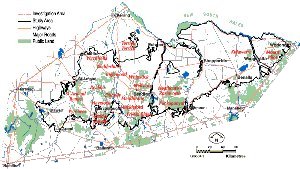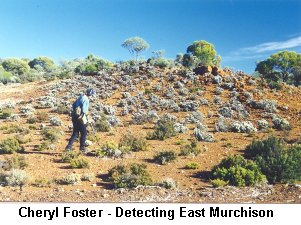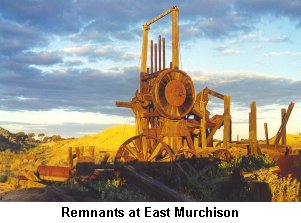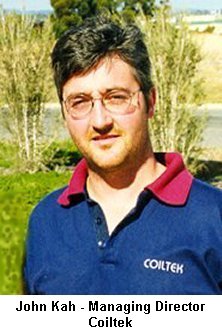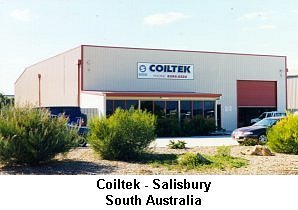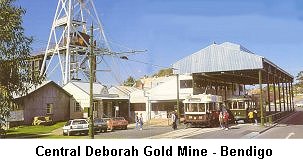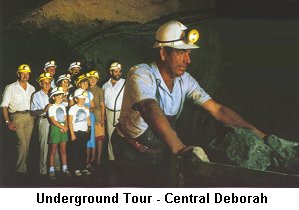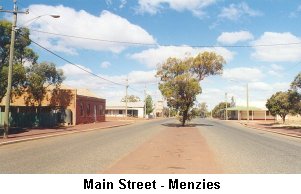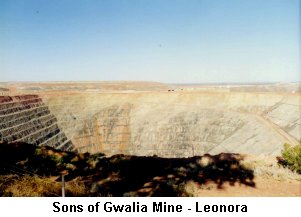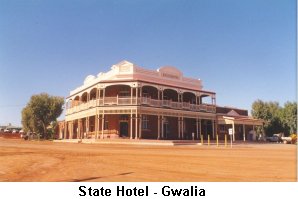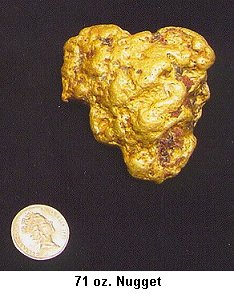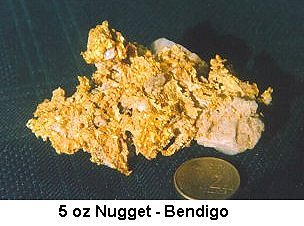
| September 2000 | |||||||||||||||||
|
|||||||||||||||||
Contents
|
|||||||||||||||||
1. EDITORIAL Another milestone has been reached by Goldnet. On the 28th August we reached the 20,000th visitor to this site. This is indeed a milestone that all here at Gold Net can be duly proud of. How ironical it is that in Victoria we have a government that is moving to close forests - while in Western Australia we have a government that is moving to open up more land for prospecting. The Victorian Government has met stiff opposition from several groups who use these forests now. Not the least being the gold fossickers, whose use of these forests have been grossly underestimated - along with the economic benefits that these "Gold Tourists" bring to the gold areas of Victoria. On the other hand the Western Australian government, while trying to open up ground to fossickers, has met stiff opposition from the larger mining companies, with the likelihood of their open policy being watered down somewhat, making it more difficult for the fossicker to prospect. It is envisaged however, that the WA government will achieve some benefits for gold fossickers.
We will monitor this closely and advise of developments as they occur in W.A.
GEAR FOR SALE: If you have gear for sale - that relates to detecting, sluicing and associated products - we will list them for sale on a commission basis. There is no up front cost for you. Arrangement by private treaty. Editor Email: [email protected] All material in this magazine is copyright and may not be reproduced in any part or form whatsoever without written permission from the publisher.
|
|||||||||||||||||
2. THE CLOSING OF VICTORIAN FORESTS by Craig Wilson The terms of reference for this debate are detailed below. "Having regard to the matters to be taken into account in investigations as provided in Section 20 of the Act, including the economic and social value of any existing and proposed development or use of the land or resources, the investigation must:
The Box Ironbark debate has raged for some months. Trying to sort the wheat from the chaff - so to speak is not easy in trying to ascertain just what this debate is all about. What prompted the change in government policy and just where this will lead the privateer who loves to detect in these forests is a matter of conjecture and perhaps personal interpretation. I do point out that this is only one view - but a view that hopefully has been gleaned after some consideration of the facts as presented.
Government clearly has a right to Govern, and we do expect them to govern sensibly and with ALL our interests being considered. From time to time however, they get it wrong, and fortunately we have the opportunity to make further representations to correct these differences of opinion, and hopefully get a reasonable consensus that tends to satisfy all who have an interest. Having read a great deal of the report, it stands out to those who are involved with the gold prospecting world, that the report clearly seems to have missed the mark in reaching a proper assessment of the forest use relating to the gold prospecting industry.
Consequently I am personally suspicious of the quoted figures - as only 17 sites were guessed at, with a further 34 park areas where gold proliferates were excluded from any assessment at all. Hardly accurate figures.
Trying to work out what the ECC (Environment Conservation Council) is trying to achieve is difficult. It appears that the thinking is based on the fact that making State Forests or State Parks into National Parks - will somehow miraculously increase their usage. To suggest that this scenario would flow through to other parks were they to be designated National Parks is flawed. Clearly there must be some catalyst to draw people to these areas. Quality facilities, coupled with a uniqueness of a particular area that will draw tourists in the numbers suggested. In my experience there are few such areas that would attract in the numbers suggested. The report also asserts that, "changing a State Forest to a State Park is likely to increase visitations, but it depends on a number of factors". However I am sure the decrease in detectorists that can no longer detect in State Parks, was not taken into account when these figures were calculated. The suggestion is that visitations would increase by 9%. If gold fossickers are denied access clearly that 9% increase would be wiped out overnight, and probably a negative visitation figure would be more like reality, unless there was substantial tourist infrastructure injected into these areas. Some of the report's assertions are puzzling. Particularly in suggesting that visitations to the Bendigo Regions Parks would increase by 90,000 visitations a year. If you have visited these parks, there is little to attract even the locals to them. The only people I have ever seen there are gold fossickers, and in the Whipstick, most definitely only gold fossickers. The suggested financial input from tourist prospectors is suggested to be as high as 20%, within gold related districts. From my experience in small gold towns in the Golden Triangle, such as Dunolly and Wedderburn - that figure is "guesstimated" to be as high as 50 - 60%. I have personally asked the hotel, motel, and caravan park owners for their assessment. These are the grass roots people that really know the true figure. Clearly this report does not reflect the economic importance of gold prospecting tourists into this area in its true sense.
The concern from the prospecting fraternity is that the available land to detect will be reduced by about 9%. These forests are a magnet to prospectors - and clearly the tourist visitations and economic impact for these regions has not been assessed with any degree of accuracy, in my humble opinion. I guess that is why this gobbledegook appears in the header of this report. "Optimal Ignorance - knowing what facts are not worth knowing. Appropriate Imprecision - Knowing that precise data are often unnecessary to reach a clear conclusion and (particularly in the case of this study) precise data are sometimes impossible to obtain." Is it any wonder that the Box Iron debate rages on. We, of the prospecting fraternity can but hope that common sense will prevail in due course, and our treasured forests will be left alone for us all to enjoy, in the peace and tranquillity that we have enjoyed for many years.
|
|||||||||||||||||
|
|||||||||||||||||
3. GHOST TOWNS OF WESTERN AUSTRALIA by Jim Foster The West Australian East Murchison goldfields of the 1890s was a dry and inhospitable place. Far from any kind of civilization, hot as Hades in the summer and dry as dust all year round the trackless wilderness around what was to become Lawlers and Agnew first felt the tread of hob nailed blucher boots in the year of 1892. Ned Heffernan, Julius Anderson and Charles Hall set off in an easterly direction from Cue in November 1892. With summer already making itself felt it must have been a trip of great danger and trial, yet these hardy independent souls travelled two hundred and forty miles each way on their exploratory trip through a hostile and unknown wilderness. It was only on their return leg that they found traces of gold in the area soon to be known as Lawlers.
Charles Hall, one of the original Heffernan party, with William Rutter and others, also made a trip to the east of Cue. Rutter died on this trip and his grave is somewhere east of Cosmo Newbery.
In the spring of 1895 Tom Cue, David Ogilvie, and J Hunter set out from Cue for Lawlers. By now the track had a number of wells, mostly about a days travel apart, and the track was well worn. Cue drove his trap loaded with supplies and tools while his partners rode. In contrast to conditions of only a year before it was an easy and relatively safe trip. By October that year Cue and his party had filed a claim about ten kilometres north of Lawlers which they called the Woronga, (ML58). The area quickly became known as Cue's Patch and produced a good deal of alluvial gold Almost immediately others took up claims around Cue's party. The combined area of reef mine claims became known as the Ogilvie Group. With the inrush of miners Lawlers and Cue's Patch soon had links with the outside world. A bicycle courier service between Coolgardie and Lawlers could cover well over a hundred kilometres a day following sand and ironstone covered tracks that wound through a wilderness where only the hardy survived. The tough as boot leather riders of steel steeds were soon followed by a camel service from Cue, then a coach run from Mt. Magnet. In 1897 the telegraph brought the world to Lawlers. Over the next few years Lawlers and Cues Patch went ahead in leaps and bounds. New mines opened up and some proved to be big producers but these mines were scattered over a wide area and each would have had to install their own stamp batteries had it not been for the ingenious tram line system. The London and Western Australian Exploration Company became active in Lawlers in 1895 and bought up several of the better mines. Among them Lawlers Donegal, the True Blue, and Gibson's Great Eastern. They quickly amassed a total of 117 acres of very productive mining lease that became known collectively as the East Murchison United Limited (E.M.U.) under the management of London based Bewick Moreing and Co. In 1896 E.M.U. brought in the first crushing plant, a ten-head battery, and winding gear installing it at the Great Easton. To feed the ten-head battery E.M.U. built the first section of tramway in 1901 to haul ore from their Donegal lease. The engine was only a small, weighing in at around six tons and could haul several carriages at speeds up to ten miles an hour. Eventually there were to be nearly twenty kilometres of tram track constructed linking most of the mines in the E.M.U. group with several engines to haul the large number of ore trucks. With efficient transport hauling ore from several mines to one central battery costs for the running of all the mines in the group were kept very low and the district prospered for some years.
The Lawlers townsite was obviously named after Patrick Lawler who found the
first gold in the nearby Lame Horse Creek, but Agnew was another matter. Tom Cue, whom the town of Cue was named after could hardly have another town named after him despite the Woronga mine being locally known as Cue's Patch for some years.
Finding a spot near the original Donegal mine we set up camp and began our tour of the district. The Lawlers cemetery is a must for anyone interested in the history of the town and an excellent list of those interred, the reason for their death, and other details, stands just inside the gate. Each grave is numbered to make it easy to find each of those listed on the board. This makes fascinating reading and at least an hour can be spent on this, one of the loneliest of God's Acres. A kilometre or so behind the cemetery is a huge sandy area covered in bottle dumps. It appears to me that each dump, mostly made up of tin cans and bottles is the site of a separate campsite. There is very little of the rubbish you would expect from established households and as in those early days almost all food was tinned and all drink bottled I am fairly certain these are the remains of the large camp said to exist near Lawlers. Many of the bottles are broken but we managed to salvage a number of interesting specimens in a fairly short time. Remains of the old tramline embankment that ran to Donegal were evident near our camp and in good condition. A short section of the original steel rail line (7 pounds to the foot) was found on the nearby old dry blowings and examined with interest. We detected the area around Agnew and Lawlers for several days and found only a few small nuggets but saw evidence of good finds being made over the last twenty years. It was a disappointing trip for the trio, they decided the area was too dry and isolated when there were better prospects closer to civilization. In June 1893 Patrick Lawler, with Donnelly, Smith, Harris, and Cafferty set out from Cue to further explore the country the Heffernan group had looked at the previous year. They found gold at Lame Horse Creek below what was to become the Donegal reef mine but had to make a hurried exit from the East Murchison due to lack of supplies. Finding a spot near the original Donegal mine we set up camp and began our tour of the district. The Lawlers cemetery is a must for anyone interested in the history of the town and an excellent list of those interred, the reason for their death, and other details, stands just inside the gate. Each grave is numbered to make it easy to find each of those listed on the board. This makes fascinating reading and at least an hour can be spent on this, one of the loneliest of God's Acres. A kilometre or so behind the cemetery is a huge sandy area covered in bottle dumps. It appears to me that each dump, mostly made up of tin cans and bottles is the site of a separate campsite. There is very little of the rubbish you would expect from established households and as in those early days almost all food was tinned and all drink bottled I am fairly certain these are the remains of the large camp said to exist near Lawlers.
Many of the bottles are broken but we managed to salvage a number of interesting specimens in a fairly short time. It was only in one spot near Lawlers that a good find was made, a six ounce slug, deep in the cap-rock had been missed by earlier detector operators. It took three quarters of an hour to free it from the cap-rock an ugly looking lump but the best to date that we had found.
While the Lawlers / Agnew ghost towns may not be a detecting paradise it is a fascinating place to explore. You can trace the old tramlines across the country, visit the cemetery and the bottle dump, view the old stamp batteries and other artifacts across the road from the Agnew Hotel and drive to the top of Agnew Bluff just out of Agnew for a breathtaking view of this incredible country. Acknowledgment Much of the material for this article came from Alex Palmers excellent book, Agnew. Should you be heading in the direction of Agnew, I strongly suggest you purchase this book as it will bring the history of the district alive for you and greatly increase your enjoyment of the area.
|
|||||||||||||||||
|
|||||||||||||||||
4. PROFILE - JOHN KAH by Brad Williams John Kah is a "Dinky Die" Aussie. Born in this country of migrant parents from the Netherlands, he has spent his entire life domiciled in the northern suburbs of Adelaide, South Australia. After completing his education John began work with Minelab in 1985 when the company was a fledgling organisation, as a member of the production staff. He remembers well the first detector that was ever put together at Minelab. It took 12 people a week to complete the first unit. The second week a total of 10, 1500 Gold Seeker detectors were assembled.
During 1988, Minelab was re-structured, and it was during that time that John accepted the contract the produce all the coils for the Minelab product range. From this time Coiltek became an identity on its own, and for some time John produced the coils from his own property until moving to a factory at Parafield as expansion occurred. One year later John bought a commercial property at Parafield, and built the factory to suit his requirements for the construction of the Minelab coils. This is the factory that Coiltek uses today to produce coils supporting the gold prospecting industry. In 1995 with the introduction of the SD 2000, the industry accelerated at a rapid rate and certainly provided the catalyst for both Minelab and Coiltek to benefit substantially from this economic boost. With the release of the SD2100 the economic boost continued. In early 1999 John Gladdis moved from Minelab to Coiltek, and together they developed the present Coiltek range of coils. As well as producing the Minelab Range they were also developing their own range to suit the Minelab SD range of detectors.
In 1999 Minelab restructured yet again and recalled the contracted out sections of their manufacturing base, as they moved into the global market place. This recall stimulated John to increase his R & D effort and develop an extensive range of coils to suit mainly professional prospectors. The recent release of the "UFO", a two-foot elliptical monoloop coil has been an outstanding success. Recovery rates on flogged ground have been exceptional, and sales of this product have been keeping the manufacturing team at full throttle for many weeks.
However John's main hobby is delving into the world of electronics, with the object of developing a better coil for the prospecting fraternity, particularly the professional prospector. Spending hours and hours on R & D, John finds this activity most rewarding. In fact he would much rather be developing new products than detecting, as he claims he does not have the patience to be a good detector operator. As the CEO of Coiltek, John Kah has developed a sound business ethos that is well recognised throughout the industry. His ability to provide a very effective product at a competitive rate and with excellent after sales service record enhances John's standing every day. We are pleased that John is an integral part of this industry.
|
|||||||||||||||||
|
|||||||||||||||||
|
5. THE CENTRAL DEBORAH MINE  by Sue "Goldie" Reynolds
The Central Deborah Gold Mine in Bendigo, Victoria had a colourful and extensive past. It was one of the great mines of the late 1800's in Bendigo at the conclusion of the great gold boom that lasted well into the 20th century. I had often driven past the mine on my way to detect the Whipstick - or on my way to the Dunolly area, and had often wondered just what was to offer here. Eventually my curiosity got the better of me and on a rather cold winters day I took the opportunity to visit. The poppet head dominates the site. It is a large structure - well maintained, and operational. The tramway tracks adjacent to the main building, under a large roofed area, houses the old trams that were so much a part of this city in bygone days. Of interest too is the restaurant tram that provides silver service to patrons whilst they undertake a tour of the cities splendid tourist sites. Indeed it is an experience to partake of a high quality meal in such a unique environment.
Replenished, I waited to be called for the tour and right on the hour we all gathered and moved off into the changing shed. Here we donned coveralls, rubber boots, and a miner's hat with light and battery. All decked out, we patiently waited under instruction at the main lift. Entering this structure the impression that one is definitely in a mine hits home. The rough shaft cut through solid rock with the sides of the cage being just that - and through the mesh one can see the shoring up and repairs as one travels downwards into the darkness with nothing but the lights of the miners lamps to light the area. It seemed an eternity - but reaching the bottom was a welcome relief, and to step out into a rather broad open shaft one immediately had the impression that it was safe. Along the sides of these broad never ending tunnels that inevitably heading downwards, and even further downwards, the reefs of gold bearing quartz could be clearly seen and in some places - behind screens gold was pointed out in these reefs, and it was clearly visible to the naked eye.
I was so glad that our guide, Bob, was with us - as there were shafts and tunnels going in all directions, and with no obvious indications, actual direction travelled is impossible to tell. Nevertheless - I felt very safe.
Along the way, deep in these tunnels, Bob pointed out where work was being done to recover gold now.
Following the many shafts and tunnels is a well designed air replenishment system that extracts dust and forces much needed oxygen into all the nooks and cranny's that abound here. There is lighting that follows most of the shafts and the feeling of being completely safe is always with you. At the conclusion of this fabulous experience we returned to Level Two, where there is a large cut-out that is used as a dining room and it was here that our hosts provided hot scones with strawberry jam and cream. That fine culinary delight settled well, and along with some verbal banter the tour was drawing to a successful close. One last look at the surrounds before heading back to the lift where with the electric motor operating within the cage itself, making communicating difficult, the trip upwards was slow but steady. Upon reaching the surface a steady thud and the motor stopped automatically. Security gate opened and we exited to the changing room once again where the rubber boots, coveralls and miners hats were exchanged for our street clothes.
Bob had been the consummate host and a particularly interesting bloke to listen to. His concern for our welfare during the underground escapade had been exceptional, and his descriptions clear and concise. The water level had flooded the mine up to the 11th level so gold recovery below that level is not possible, at least at this time. But the present day miners are confident they can locate sufficient gold bearing reefs to keep the operation buoyant for the foreseeable future. I must say that the two hours spent down this mine was a most enjoyable and in fact exciting experience, and one that can be thoroughly recommended, if you have the slightest interest in gold mining.
|
|||||||||||||||||
|
|||||||||||||||||
6. WESTWOOD HO - PART 2 by Brad Williams Leaving the gold town of Kalgoorlie, one cannot help but notice the huge mines that proliferate on both sides of the highway for some distance out of Kal. The huge trucks or should I say road trains, as most of them have 3 and 4 trailers attached as they move about this remote region clearly indicate the huge wealth that abounds here. The road is exceptionally good, as it heads ever northward towards Menzies and Leonora. Menzies is a small town - almost a ghost town - except for the hotel and a couple of small stores - a modern service station - caravan park an old hall and some assorted communication facilities. Although it was mid winter - the warmth of the sun could be felt here. Although not that far north of Kalgoorlie, the degree of warmth from the sun was noticeable. In bygone days Menzies has been a boomtown - but today a sleeping dot on the map enroute further north.
As one nears Leonora the country changes somewhat - displaying some prominent outcrops. Just to the south of Leonora lies the old mining town of Gwalia. This small township still resembles a gold mining town at the turn of the last century. The Sons of Gwalia gold mine is here. It is a huge open cut mine, and when visiting it - I could not find a site that I could move to, that enabled me to see the bottom of this huge pit. This mine made famous by Herbert Hoover when he was an engineer here, has been producing gold for over 100 years. Leonora itself has some surprises. Clearly its main role is supporting the many mining camps that exist in and around this area. Within the town itself - there are two service stations, quite a big supermarket, two hotels, several mining camps within the town itself, including "The Minesite Village" who will accommodate private people. The caravan park although not huge - is quite a nice establishment with owners that make you very welcome, providing overnight camping for as low as $6.00, and there is a motel near the centre of town that is quite acceptable, although not all that cheap.
This town is a frontier town, there is no doubt about that. Walk into the hotels in the evenings and scantily clad young ladies will be behind the bars, displaying their talents. Take away food shops flourish especially in the evenings, and the supermarket does a roaring trade, as does the video shop. But the real draw card here is gold. Gold is plentiful here. The auriferous ground here is everywhere, unfortunately most of the best ground is well held by leases, that prevent one detecting. Just north east of the town, about 6km out is an area called the "specking patch". It is an area that stretches for about 10-12 km. and is about 3-5 km. wide. Although this area only hides small gold, it is a good area to detect - even if the pickings are a little slim, as it has been worked over pretty well.
Another good area is Murrin Murrin Station. Although when we were there the traffic was a little thick - more like the main street of Leonora.
The ground here has been turned over as well, but we did hear of one couple finding several ounces - although they had been here for about 5 weeks.
Although we were here for only a few short hours - pickings were slim.
While there I ran into friends I had not seen for many years. Robyn and Shirley were telling me about the gold they see in the supermarket. During the last week they had seen a specimen piece containing 110 ounces of gold encapsulated in quartz. There was also the story of the 18 year old that found a 40 ounce piece just 4 kilometres from town along the side of a road. I never seem to have that luck. What was obvious here was the difference in the country compared to Victoria. A good deal of the ground has large gibber rocks strewn over it - making it difficult to keep a detector coil on the ground. One can understand why most prospectors in the west use large coils. Simply a matter of practicality. It is not always the case as there are large areas of ground where the coil can he right on the ground where it should be. But keeping large coils in the west is an obvious requirement. Although I did not have one with me - I was told by plenty of operators there that the new elliptical from Coiltek, was getting exceptional results. So if you are heading for the west - bring a good supply of deep coils with you, and include the new elliptical for best results.
The west is still a great place for prospecting. You will find the people friendly and helpful, and the experience of the west a great adventure.
|
|||||||||||||||||
|
|||||||||||||||||
7. FLECKS ! - Glints from here and there
|
|||||||||||||||||
|
|||||||||||||||||
8. STRIKES Recent Finds
|
|||||||||||||||||
|
|||||||||||||||||
|
9. THE NEW LODE - Next Month's Issue
|
|||||||||||||||||
|
|||||||||||||||||
